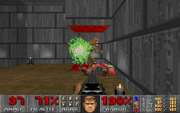A teleporter moves players and/or monsters from one location on the map to another, almost instantly, with a flash of green fog and a whoosh noise (DSTELEPT).
Background[]

A teleporter in use on E2M1: Deimos Anomaly
Teleporters are the main element in the backstory of the original Doom, and within the series, being used by both Hell and the UAC.
In the Doom series, any being (i.e Demon, Player character) that is in a certain radius of the teleportation pad will be telefragged, which can be (albeit unofficially) explained by the force that has the greater "Dimensional Momentum" (essentially the second object is "shot through" the first object, due to the overlapping X/Y axis, much like some sort of "Quantum Bullet")
Classic Doom[]
In the original series (Doom, Doom II, Final Doom, and Doom 64) Phobos and Deimos are being used as testing grounds for teleportation experiments, typically small objects are teleported with success, however in the recent time before the events of the original game, Humans who are teleported either vanish, or when successfully teleported become suddenly aggressive, before violently exploding, the UAC however claims this is just a small setback and everything is in control.
After a likely experiment, the gates of Hell are supposedly opened, and Deimos vanishes from the sky, and Phobos sends a fearful message, and the Doom Marine's squad are sent from Mars to investigate. After defeating the demons, the Doom Marine is teleported to Deimos.
Doom 3[]
Doom (2016)[]
Gameplay[]
If a monster or player is on the landing spot at the time of teleporting, monsters will not teleport but players will, killing whatever was on the landing spot. This is known as a telefrag. A player will self-telefrag if a voodoo doll is on the landing spot. In vanilla implementations, moreover, monsters can telefrag each other or the player on MAP30 of any WAD (some source ports allow the player to disable this exception or apply it to every map).
Map Editing[]
Conventionally, a teleporter is constructed as a 64-unit square with a distinctive floor texture; however, this is not a technical requirement. All sides of a teleporter usually teleport to the same place, but again this is not required: some levels attempt to confuse the player by sending them to different places depending on which side the teleporter is entered from. An example of both of these instances can be seen in MAP18: The Courtyard in Doom II, where the player is teleported without warning when entering a particular room but is not teleported when leaving that room.
Linedefs[]
In Vanilla Doom, there are four linedef types for teleporting. These implement the combinations of one-time versus repeating and players or monsters versus monsters only. All of them are of the walk-over variety.
Teleporter linedefs are direction-sensitive. This is necessary for cases where the landing area is another teleporter, so that the player can walk off the landing spot without teleporting again.
The linedef's tag specifies the destination sector (the lowest-numbered sector with the same tag value). Within that sector, there must be a teleport landing thing, which specifies the coordinates and angle the player or monster will have after teleporting. Barrels will also teleport if they cross a teleport linedef while being pushed from damaged.
Boom introduced some extended teleporter line types, including switch-activated teleporters and silent teleporters. The latter preserve player orientation, position, momentum and height so that the teleport may not be noticed; this can be used to simulate rooms over rooms and for other special effects.
Trivia[]
- The use of teleporters in the Doom series, was inspired by John Carmack's Dungeons & Demons game, where Demons would break loose on the world, and kill the protagonists.
